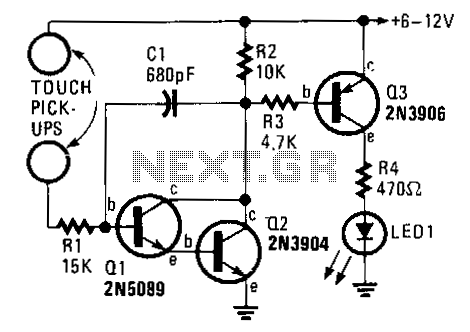
Two-terminal-touch-switch

This circuit requires the bridging of two circuits to activate the electronic switch. It does not require a 60-Hz field to operate and can be powered by either battery or AC. The two pickup terminals can be made from most clean metals and should be approximately the size of a penny. The input circuitry of the two-terminal touch switch consists of a high-gain Darlington amplifier that amplifies the small bridging current to a sufficient magnitude to turn on Q3, which supplies power to LED1. If a quick on-and-off switching time is desired, the value of C1 should be very small; if a longer on-time period is required, the value of C1 can be increased.
The circuit described operates as a touch-sensitive electronic switch, utilizing a Darlington amplifier configuration to achieve high sensitivity and low input current requirements. The two pickup terminals, positioned to allow for user interaction, serve as the input points where a small bridging current is generated when touched. The choice of materials for these terminals is crucial; clean metals ensure good conductivity and reliable performance.
The Darlington amplifier, composed of two bipolar junction transistors (BJTs), provides a high current gain. This means that even a minute current flowing through the pickup terminals can be amplified to a level sufficient to activate the transistor Q3. The activation of Q3 subsequently allows current to flow to LED1, illuminating the LED as an indication of the switch being engaged.
Capacitor C1 plays a significant role in determining the switching characteristics of the circuit. A smaller capacitance value results in a rapid response time, allowing the LED to turn on and off quickly upon touching the terminals. Conversely, increasing the capacitance value of C1 will extend the on-time of the LED, creating a more prolonged illumination. This feature allows for customization of the circuit's response according to user needs, making it adaptable for various applications.
Overall, this touch switch circuit is versatile and can be effectively utilized in numerous electronic projects, providing a reliable and user-friendly interface for activating devices without mechanical components.This circuit requires the bridging of two circuits to activate the electronic switch. That circuit does not require a 60-Hz field to operate and can be battery or ac powered. The two-pickup terminals can be made from most any clean metal; they should be about the size of a penny. The input circuitry of the two-terminal touch switch is a high-gain Darlington amplifier that multiplies the small bridging current to a value of sufficient magnitude to turn on Q3, supplying power to LEDl.
If a quick on and off switching time is desired, the value of Cl should be very small; if a long on-time period is required, the value of Cl can be increased.
The circuit described operates as a touch-sensitive electronic switch, utilizing a Darlington amplifier configuration to achieve high sensitivity and low input current requirements. The two pickup terminals, positioned to allow for user interaction, serve as the input points where a small bridging current is generated when touched. The choice of materials for these terminals is crucial; clean metals ensure good conductivity and reliable performance.
The Darlington amplifier, composed of two bipolar junction transistors (BJTs), provides a high current gain. This means that even a minute current flowing through the pickup terminals can be amplified to a level sufficient to activate the transistor Q3. The activation of Q3 subsequently allows current to flow to LED1, illuminating the LED as an indication of the switch being engaged.
Capacitor C1 plays a significant role in determining the switching characteristics of the circuit. A smaller capacitance value results in a rapid response time, allowing the LED to turn on and off quickly upon touching the terminals. Conversely, increasing the capacitance value of C1 will extend the on-time of the LED, creating a more prolonged illumination. This feature allows for customization of the circuit's response according to user needs, making it adaptable for various applications.
Overall, this touch switch circuit is versatile and can be effectively utilized in numerous electronic projects, providing a reliable and user-friendly interface for activating devices without mechanical components.This circuit requires the bridging of two circuits to activate the electronic switch. That circuit does not require a 60-Hz field to operate and can be battery or ac powered. The two-pickup terminals can be made from most any clean metal; they should be about the size of a penny. The input circuitry of the two-terminal touch switch is a high-gain Darlington amplifier that multiplies the small bridging current to a value of sufficient magnitude to turn on Q3, supplying power to LEDl.
If a quick on and off switching time is desired, the value of Cl should be very small; if a long on-time period is required, the value of Cl can be increased.